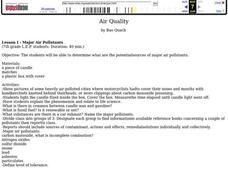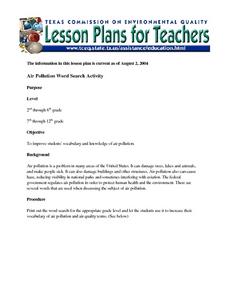Curated OER
Air Quality Issues
Students identify the different layers of the atmosphere. They examine the different types of air pollutants. They also discover laws in effect that work to protect the environment.
Nemours KidsHealth
Germs: Grades 3-5
Young scholars investigate personal health issues by discussing germs. In this contagious disease lesson plan, students identify ways germs infect our bodies and how we can best protect ourselves. Young scholars discuss food...
Curated OER
Chemicals, Chemicals, Everywhere
Students divide substances into categories: made of chemicals/not made of chemicals, synthetic/naturally occurring, and toxic/nontoxic. They observe a mystery chemical and determine what precautions they need to take when handling an...
Curated OER
Specialized Structures and Environment
Fifth graders read about how different animals protect themselves, and how characteristics give animals an advantage in their environment. Students then discuss a variety of "outer" wear for humans, and what they might choose to wear in...
Curated OER
Air Quality
Students determine potential sources of major air pollutants, explain how acid rain is generated and how it affects the environment, discuss global warming, and explore protective role of ozone and cause of ozone layer thinning. Lessons...
Curated OER
Oil Spill Dangers
Students analyze the effects of oil spills on our environment and develop action plans to protect animals and habitats.
Curated OER
Toxic River
Students explore environmental safety by participating in a class game. In this toxic chemicals lesson, students discuss the effect chemicals have on our environment and how to best protect against their dangers. Students participate in...
Learning Games Lab
Nitrogen in Pollutants
Responsible farming is important for maintaining natural resources. Eager scientists complete a WebQuest to explore what happens to nitrogen when it enters the soil. They learn about the chemical makeup of nitrogen-based molecules and...
Curated OER
Defining Hazardous Waste
Students examine the relationship between hazardous substances and hazardous waste. They identify toxic chemicals and how they are disposed of. They work together to answer questions about how they are improperly used.
Curated OER
More Acid-Base Indicators
Learners explore acids, bases, and indicators. They use turmeric solution, phenolphthalein, and goldenrod paper to determine the acidity and basicity of a variety of common household substances. A worksheet is included to record test...
Curated OER
EPA Pesticides Reduction
Young scholars examine the effects of pesticides on the environment and bugs. They answer questions as an assessment.
Curated OER
Air Pollution Word Search Activity
Pupils examine the issues surrounding air pollution. They discover how it affects peoples health and the government's regulations. They complete a word search activity to practice the vocabulary.
Curated OER
Learning Activities: What Color Am I?
Pupils identify various species of anurans by their skin coloration. They describe how coloration contributes to survival.
Curated OER
Forests
Learners examine soil in forests looking for animals and insects. They divide the animals based on their number of legs and draw the animal they have collected.
Curated OER
Insect Collection
Young scholars investigate about various biological aspects of life, while examining desert insect species. They see the diverse range of species that live in the desert, despite the apparent lack of life in the desert. students...

















